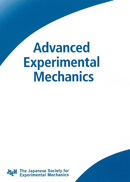Volume 6
Displaying 1-16 of 16 articles from this issue
- |<
- <
- 1
- >
- >|
Special Submission
-
Article type: research-article
2021Volume 6 Pages 3-11
Published: August 31, 2021
Released on J-STAGE: December 09, 2021
Download PDF (1497K)
Fluid and Thermal Engineering
-
Article type: research-article
2021Volume 6 Pages 13-20
Published: August 31, 2021
Released on J-STAGE: December 09, 2021
Download PDF (4271K) -
Article type: research-article
2021Volume 6 Pages 21-26
Published: August 31, 2021
Released on J-STAGE: December 09, 2021
Download PDF (1160K) -
Article type: research-article
2021Volume 6 Pages 27-32
Published: August 31, 2021
Released on J-STAGE: December 09, 2021
Download PDF (3754K)
Solid Mechanics and Materials Engineering
-
Article type: research-article
2021Volume 6 Pages 33-38
Published: August 31, 2021
Released on J-STAGE: December 09, 2021
Download PDF (1886K) -
Article type: research-article
2021Volume 6 Pages 39-46
Published: August 31, 2021
Released on J-STAGE: December 09, 2021
Download PDF (4105K) -
Article type: research-article
2021Volume 6 Pages 47-52
Published: August 31, 2021
Released on J-STAGE: December 09, 2021
Download PDF (1933K) -
Article type: research-article
2021Volume 6 Pages 53-58
Published: August 31, 2021
Released on J-STAGE: December 09, 2021
Download PDF (2435K)
Materials Science and Processing
-
Article type: research-article
2021Volume 6 Pages 59-64
Published: August 31, 2021
Released on J-STAGE: December 09, 2021
Download PDF (3997K) -
Article type: research-article
2021Volume 6 Pages 65-70
Published: August 31, 2021
Released on J-STAGE: December 09, 2021
Download PDF (5163K) -
Article type: research-article
2021Volume 6 Pages 71-76
Published: August 31, 2021
Released on J-STAGE: December 09, 2021
Download PDF (2585K) -
Article type: research-article
2021Volume 6 Pages 77-82
Published: August 31, 2021
Released on J-STAGE: December 09, 2021
Download PDF (1769K)
Damping and Vibration
-
Article type: research-article
2021Volume 6 Pages 83-89
Published: August 31, 2021
Released on J-STAGE: December 09, 2021
Download PDF (3002K) -
Article type: research-article
2021Volume 6 Pages 90-97
Published: August 31, 2021
Released on J-STAGE: December 09, 2021
Download PDF (2823K)
Geoenvironmental Engineering
-
Article type: research-article
2021Volume 6 Pages 99-103
Published: August 31, 2021
Released on J-STAGE: December 09, 2021
Download PDF (2388K) -
Article type: research-article
2021Volume 6 Pages 104-109
Published: August 31, 2021
Released on J-STAGE: December 09, 2021
Download PDF (1975K)
- |<
- <
- 1
- >
- >|
